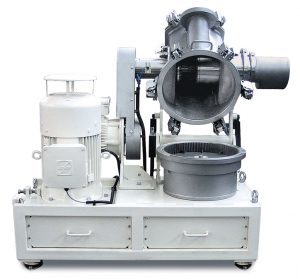
Today’s supermarket shelves are bursting with protein enriched and high protein extensions of branded product ranges. Cereals, breakfast and snack bars, drinks, sports compounds and even chocolate commonly announce their high protein status alongside the benefits of eating protein.
Proteins are a key building block of living organisms along with carbohydrates and fats and are indispensable for human and animal nutrition and high protein variants are merchandised with the benefits of muscle building, weight loss and keeping you feeling fuller for longer.
Today’s protein concentrate technology is focused on vegetable proteins as a more healthy, sustainable and responsible sourcing option than animal protein.
Hosokawa Micron has been helping companies boost vegetable protein concentration for many years and continues to develop the technology to deliver concentration values to between 40 and 70% protein. The basis of the protein shifting process is to take a natural vegetable product such as a legume, with a defined protein value and split this into two fractions; one with a higher protein level and one with a protein level lower than the feed material.
There are two different processes available for the user with the lower energy standard process the favoured method of manufacturing the protein concentrate for all the starchy seeds named here. The quality of the end products is thereby aimed at meeting current minimum market requirements. However for meeting the maximum requirements in both qualitative and quantitative terms, Hosokawa’s high-precision process, which uses a higher efficiency classifier (more energy input) is available.
The range of protein yielding plant based seeds is extensive with peas, soya, fava beans, rapeseed and sunflower seeds identified as having dry matter protein levels of between 22 – 26% and being suited to dry, mechanical processing methods of protein shifting.
Give Peas a Chance
The humble peas. One of the oldest known vegetables offers plant-based protein levels of 20-25% and good processing attributes. Grown across the world, the peas is increasingly identified as a super plant in terms of its ability to help meet the escalating demand for protein to feed the world’s population. Here we look at how Hosokawa Micron’s established protein shifting process is applied to the processing of peas.
The basis of the mechanical manufacture of protein concentrates is the disintegration of the core conglomerate into its individual components. The composition of peas includes two main components for the disintegration process.

Assuming that the shell and thus the fibres have been removed, what remains is protein (approx. 23%) and starch (approx. 55%). These are fed to a Zirkoplex classifier mill, capable of accurate particle size reduction. An optimum disintegration degree of the pea’s protein, starch, etc. is thus ensured.
After the grinding process, the components thus liberated are separated in a downstream air classifier. The various constituents are dispersed as a function of their density in the airflow and
routed to the classifying wheel. The classifying wheel parameters make an effective separation of the ground dispersed material possible.
The classifier yields two end products, i.e. the fines fraction with a high proportion of protein or protein concentrate, and a coarse fraction with a high proportion of starch and a strongly depleted residual protein content. Dependent on the degree of material disintegration, up to 70% of the protein portion can be routed to the fines fraction.
Besides protein enrichment, the concentrated starchy raw materials in the coarse fraction can be employed for industrial applications in new and attractive markets.
Soya Grits and Rapeseed
In the case of these oleriferous plant seeds, the protein concentrate is generated as the end product from the oil extraction process.
The grits, comprising mainly fibres and proteins, remaining after the extraction process are fed to a grinding step that is usually combined with drying. The two raw materials are again separated in the downstream air classification process as a function of the different densities into the two fractions, i.e. coarse material and fine material. Protein enrichment of up to 70% can be achieved with this process in the case of soya grits. If one considers the market values of soya grits and soya grits concentrate, it is possible to almost double the margin in this way.
Furthermore, optimum composition of different amino acids can be achieved by processing different raw materials. The diversity of systems which permit the processing of different raw materials on one and the same installation is a significant production advantages. With over 40 years’ experience and expertise in protein shifting Hosokawa offers both the standard process and a high-precision process, which uses a higher efficiency classifier (more energy input) to meet customer requirements in this respect.
| Comparison of standard and high-precision process | ||||
| Standard process | High-precision process | |||
| Fines portion | Protein content | Fines portion | Protein content | |
| Peas (yellow) | 30 % | > 50 % | 35 % | > 55 % |
| Beans (fava beans) | 25 – 30 % | > 60 % | > 35 % | > 60 % |
| Lupins (white) | not possible | > 40 % | > 60 % | |
| SPC (soya protein concentrate)* | > 60 % | > 65 % | 65 % | > 65 % |
*Soya grits with approx. 50-55% protein was used as a basis



